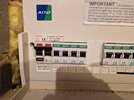Hi, apologies if the answer is already elsewhere on the forum but I could not immediately find it.
Main bedroom sockets is its own circuit and MCB (it was built as an extension post house build). Short story: none of the sockets are working with the MCB lever up. Longer story: I was about to do some work on the lights in the room. Plugged a lamp into one of the sockets (it worked). Switched off the MCB at the consumer board. Realised I switched off the Extn Skts MCB not the Extn Lights MCB, and switched it back on. Then found the sockets were US.
Can MCBs "fail" like this ? I have tried putting the lever up and down again a couple of times - yes I know that sounds a bit 'desperate' but so does coming on here and then being told I'm an idiot for not trying that first
If they can fail, how do you check to get a compatible MCB to replace it ? I ask that, because its an Alto CU and a quick search is failing other than hits on flea bay. I have noticed some comments on the forum about not using MCBs other than from the CU manufacturer.
This is potentially quite a problematic situation for us: we are having the bedroom ripped out and replaced*, with electrician coming in to do some preparatory electrical works. The works due to start in a weeks time and is going to be problematic if there is another problem to sort out first. I also have only a little spare time between now and then due to unfortunate circumstances.
*this is why I was about to do some work on the lights: removing the 'chandalier' lights and put in temporary pendant lights so they are not a hazard/get whacked with boards etc.
Main bedroom sockets is its own circuit and MCB (it was built as an extension post house build). Short story: none of the sockets are working with the MCB lever up. Longer story: I was about to do some work on the lights in the room. Plugged a lamp into one of the sockets (it worked). Switched off the MCB at the consumer board. Realised I switched off the Extn Skts MCB not the Extn Lights MCB, and switched it back on. Then found the sockets were US.
Can MCBs "fail" like this ? I have tried putting the lever up and down again a couple of times - yes I know that sounds a bit 'desperate' but so does coming on here and then being told I'm an idiot for not trying that first
If they can fail, how do you check to get a compatible MCB to replace it ? I ask that, because its an Alto CU and a quick search is failing other than hits on flea bay. I have noticed some comments on the forum about not using MCBs other than from the CU manufacturer.
This is potentially quite a problematic situation for us: we are having the bedroom ripped out and replaced*, with electrician coming in to do some preparatory electrical works. The works due to start in a weeks time and is going to be problematic if there is another problem to sort out first. I also have only a little spare time between now and then due to unfortunate circumstances.
*this is why I was about to do some work on the lights: removing the 'chandalier' lights and put in temporary pendant lights so they are not a hazard/get whacked with boards etc.



